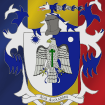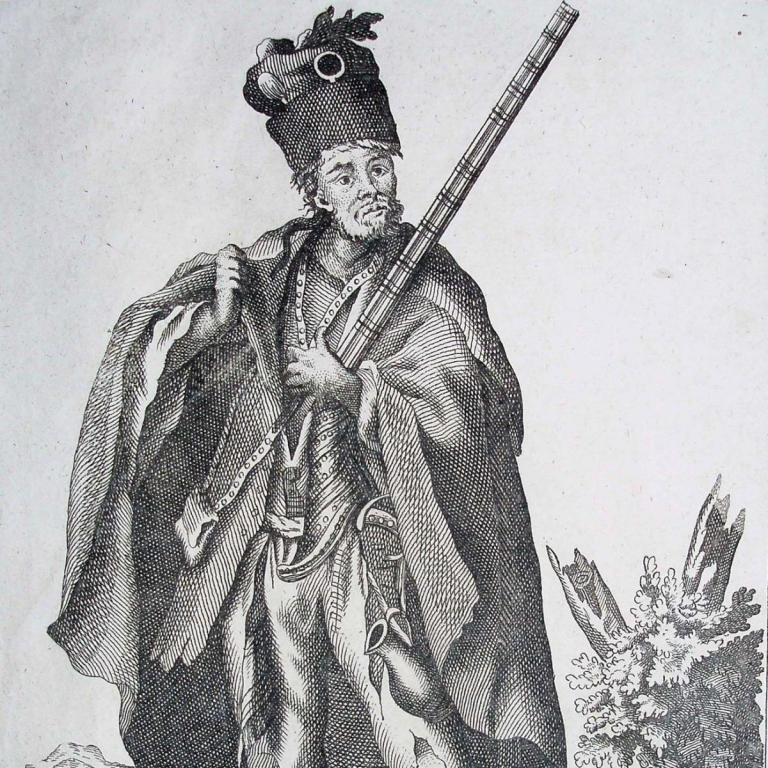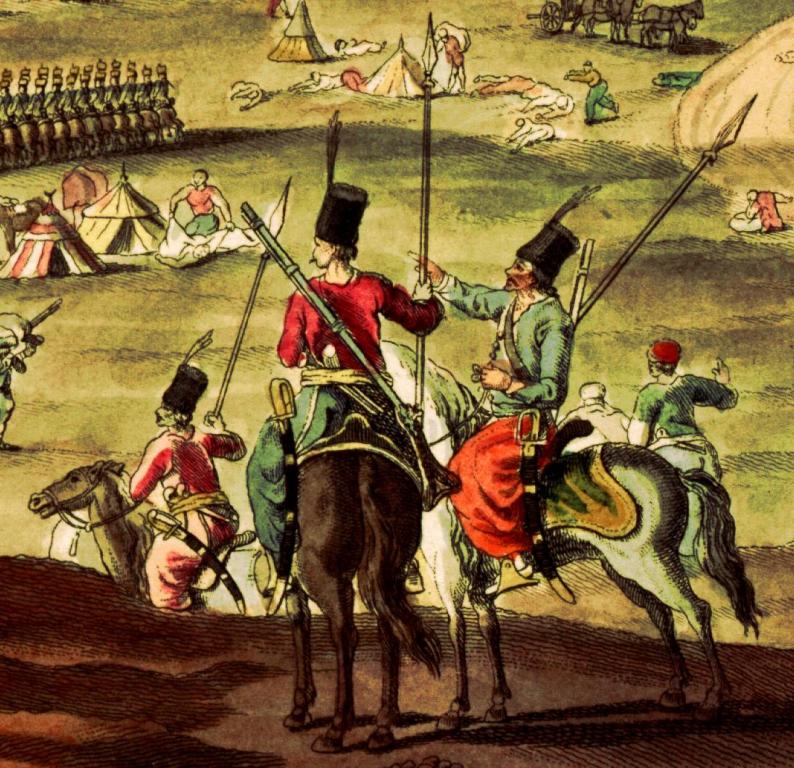-
Posts
5 -
Joined
-
Last visited
-
Days Won
1
Content Type
Profiles
Forums
Blogs
Gallery
Events
Store
Everything posted by Alin_Alexandru
-

Wallachian and Moldavian uniforms 1750-1815?
Alin_Alexandru replied to Morar Andrei's topic in Napoleonic Wars
Found some new information. Also from the Historia magazine, the issue from June this year with the article about Nicolae Mavrogheni (ruled between 1786–1789). But before getting to that I'll also start with this: -A fresco from Bistrița Monastery, Vâlcea. From the end of the 18th century. -And a fresco form the Urşani church, Vâlcea. Church was built in 1800, with the frescos being completed around 1806. Both photos were taken by Radu Oltean for his blog, art historia. The frescos show hunting scenes, both characters are Vânători (Hunters), what's interesting is the musket of the first one and the clothes of the second. While in the first hunter appears in folk clothing, the second hunter appears in a kind of Western fashion uniform. I thought that maybe he's an Austrian soldier but for one, this wouldn't make much sense considering when the church was built and two, I couldn't find any Austrian uniforms that match, red uniform with green on the inside, red pants and black or dark brown boots and I couldn't find anything on the hat, other than it kinda resembles an Austrian helmet. He also isn't the single one in the fresco, at least 5 other hunters appear with the same uniform (you can see them in a photo on google maps, the fresco is above the entrance in the church). So unless they're Austrian soldiers for some reason with unknown uniforms, they could be the hunters of some boyar in the region who decided to dress them in this fashion. So, moving on to Mavrogheni's army. There's this engraving by Hieronymus Löschenkohl titled "Anmarsch des Grosvezirs mit der Armee", it also appears in the Historia article (though a different colored version) and there it says it's the retinue of Mavrogheni. While Mavrogheni appears in the engraving this retinue doesn't match the description of the one he entered in Bucharest with. There are also a lot of Ottoman troops and officers so if this was his 'retinue' then it maybe is only the one that escorted him out of Constantinople on his way to Wallachia. However I did manage to identify a type of troop that did exist in the armies of the Principalities of that time (or at least the troops match the description). But before I get to that I'll write the description of his army when he entered Bucharest on 16 May 1786, the description comes from Dionisie Eclesiarhul written a day later on the 17th of May. Some notes before: I will keep the original terms and offer translations where possible in parentheses; the term "steag" (meaning banner) doesn't only refer to an actual banner but rather to a military unit, a banner was made up of 50-180 men so company size, other military units were the "ceată" 300-800 men, so battalion size and the "pâlc" or "polc" 2000-4000 men, so kinda in between a regiment and a brigade in size. Right, so here's the description, get ready because it's a long one, I'll try my best to translate it: This lord (Mavrogheni), entered the capital with great pomp, wearing an imperial cucă (the hat that phanariot voivodes wore) and brought 2 cannons with him. -In front came the banner (referring to the unit) of the catane of the country, with their captain, all mounted and armed. Then followed the Breasla Agiască(Guild of the Agie, the troops at this point were organized in so called guilds depending on who they served, the Agie was an organization tasked with keeping public order in the capital so like a police force for the city, they were commanded by the Great Aga). -The Călăreţi polcovniceşti (călăreţi means riders, I'm guessing the călăreţi polcovniceşti means something like regimental riders), all mounted and armed. -The "Vel căpitan" (the great captain) of the Cossaks, with his banner, with the Sârmaci (trumpeter) and his drummer. -Talpoşii Dorobănţeşti (see the Historia article from the previous posts) on foot, with chivere (helmets), with drums and their "cimpoile" (bagpipes). -The Vel Captain of the dorobanţi with his zapcii and his banner. -The Podari (bridge guards), all on foot. -The Agieşi Cossaks, also on foot with their drums and bagpipes. -The Vânatori (Hunters) as well. -The Agieşi captains, all armed and on foot. -Ceauşul Agiesc, with the Polcovnic of the ciocli. -The Polcovnic of the hunters, with the Polcovnic of the bridge (so these are the commanders of the respective polcs). -The Polcovnic of Târgovişte, with the Agiesc Logofăt. -Vel Aga dressed in the usual way. -The banner with the banerman of the Agie and riders with "prapori" (a type of flag) and with trumpets and drums. -The Neferii, all mounted and armed, carrying the "bairac" (another type of flag). -Beşlega (the captain of the Beşlii, if I remember correctly they were Tatar mercenaries). Then followed the Breasla Spătarească (so the guild lead by the Spătar): -The Lefegii with the banner, on horseback. -The Vel Captain of the Lefegii with his zapcii and the "buciumaş" (so the bucium player), the drummer and the trumpeter after him. -Scutelnicii spătăreşti, all armed. -The Poteraşi, all armed, mounted, with "fistichii" clothes (meaning pistachio colored clothes) and blue with "moţuri" (meaning plumes) and their musicians. -The Delii (Turkish mercenaries), all armed with spear in hand, together with their Odobaşi (their commanders). -The Seimeni, all armed, with red clothes and yellow plumes. -The Captains of the Spătar. -The Ceauş of the Spătar with the Polcovnic of the hunters (mentioned again, probably the commander of a different polc of Vânatori). -The Polcovnic of the Poteră, with the Vătaf of the Spătar. -The Polcovnic of the Seimeni, with Başbuluc-başa. -The Logofăt of the Spătar, with the Captain of the "meziluri" (post offices). Then followed the commander of the army: -The Vel Spătar, with his usual clothes. -The banner with the bannerman and the buciumaşi and the Lefegii, with prapore, and trumpets and drums and the Sârmaci after him. -The Păhărnicei (troops lead by the Paharnic), with copii de casă (sons of boyars). -The Vătaf of the păhărnicei with the Vătaf of the treasury. -The Aprozi of the ceauş. -The Ceauş of the aprozi with the Vătaf of the aprozi. Followed by the Breasla Portărească (the guild of the gates, I'm guessing they were tasked with defending the gates of the city): -The Portărei, formed in line. -The Second Portar with the Third Portar. -The Vel Portar. -The "Veliţi" Boyars (great boyars) and after them the Staroste with the "neguţători pământeni" and the "neguţători de companie" (merchants of the land and of the company). The followed the Breasla Armăşească (the guild of the Armaş, tasked with looking after the prisons and as well as delivering punishment decided by the Voivode): -The Armăşei with the "puşcaşi" (puşcă would translate to rifle but at this point it translates more to well, musket). -The Third Armaş with the Second Armaş. -The Vel Armaş with his usual clothes, having all the princely lăutari (so, musicians) with him. -The banners of country and the princely trumpeters with German musicians. -The tuiuri (the flags of the Voivode). -The "Juruk Bairak" (an Ottoman flag). -The Sacagii, with the sacale (these were barrels mounted on wheels used to transport water). -The Salahori with sticks in their hands (they were servants of the Princely stables). -The Second Comis and on his right the Rahitivan (also servants of the stables). -The Second Postelnic. On his right, 6 Postelnics of the horses. -The Third Postelnic with the Third Vistiernic. -The Third Logofăt with (another) Third Logofăt... (then it lists some other boyars). -On the right of the Guild there were all the Riders with their Vătaf. Then they were followed by two Imperial Ceauşi (Ottoman Imperial that is), behind them 2 Imperial Capugii. On their left were 5 Agieşi Captains with turbans. On the right there were 6 Fuştaşi with darde (*I will get back to this type of troop). Then came the Iuzbaşa followed by the Ciohodari and Memni Agasi (not sure who this is) with his Ciohodari, all flanked by 6 Fuştaşi and on the right 5 stegăreşti captains wearing turbans. The followed the Galiongii (these were the troops seen besides him in that engraving from by other post, they were specifically created by Mavrogheni and wore sailor uniforms, hence the name "galiongii" from galleon, because Mavrogheni was a Dragoman of the Fleet before becoming Voivode), in lines of 4 with their captains. Six Satâraşi, in 2 lines, followed by the Medelnicer, ...(some other boyars listed). On the left they were flanked by all the Lipcani with their Odobaşi. They were followed by Imperial Paici, the Delibaşa with all the Ciohodari, the commander of the Tufecii with all his Ciohodari, followed by other Ciohodari and Tufecii with muskets. Then came the Vătaf of the Divan with the quivers and the Second Spătar with the saber and the topuz (all these were given to every Phanariote lord when they got the throne, the topuz was a ceremonial mace, something like a scepter). Behind them came the banner of the ruler, the green flag with crescent (this flag was given to the Voivode by the Sultan). After came all the Copii de casă and 20 great boyars, with all the Ediclii and after came the Princely Marching Band. Finally, at the end, came the carriage of Prince Mavrogheni. So, the Fuştaşi. These are what I think are the Fuştaşi in the engraving above, unless they are some Turkish troops that look very similar (the image is the same from the magazine, with the different colors). They were a type of guard troop that appeared in the late 16th century in Wallachia and in the early 17th century in Moldavia (before that there were the Suliţaşi in Moldavia). As their name suggests they were armed with the "fuşte" (which is why they are correctly called "Fuştaşi" and not "Fustaşi" as they are sometimes referred to). This fuşte is a kind of spear, that's what every definitions calls it, but I'd rather say it was a pike as it's also sometimes called a lance meaning that is a long spear. There were 3 types of Fuştaşi: "de Poartă" (of the Gate, they guarded the prison of the princely court), "de Divan" (used sometimes as couriers, they guarded the princely court especially the Divan here meaning the room of the Royal Council, I'm also guessing they escorted the Voivode himself when needed) and "de la Doamna" (of the Lady, they guarded the rooms of the Lady so the rooms where she lived). Their numbers were around 12 to 30 of each type, though there could've been more than that, Dimitrie Cantemir mentions 24 Fuştaşi in his Description Moldavie, that would accompany the Voivode on his travels. And as for how they looked like, there's no descriptions before the 18th century (besides their main weapon). There are descriptions from the 18th century however. In Wallachia the fuşte started to be called "dardă", which was a kind of short Turkish spear, though the spears they carried aren't that short, they are about the length of the 18th century pikes. They also appear on a painting with Mavrogheni. They do look a bit different, though you can't see much of their uniforms, and they still have the tall hats. The one in front is also holding a much smaller spear (which is closer to the description of the dardă), so he's probably their commander or something like that. More info on the Fuştaşi here https://www.academia.edu/40810549/DOAMNELE_ŞI_DOMNIŢELE_ÎN_ISTORIA_ROMÂNILOR._CURTEA_DOAMNEI_ÎN_MOLDOVA_ŞI_ŢARA_ROMÂNEASCĂ (from chapter 3, the part about the Fuştaşi) -

Wallachian and Moldavian uniforms 1750-1815?
Alin_Alexandru replied to Morar Andrei's topic in Napoleonic Wars
So as promised if I find more information I'll post it. I got the Historia magazine that had the article about the Phanariote armies and there's some more information there as well as some interesting images. Before I start, all information will be from what's in the magazine as I don't know what sources were used exactly. The troops of both Moldavia and Wallachia were very similar to each other (since most pahariote voivodes ruled some time over one then were moved to the other) with minor differences in terms of clothing and colors (at least from the 19th century Wallachia used blue and yellow for their troops and Moldavia used blue and red). First let me talk about the armament, the uniforms and other general information. About the armament, all the troops whether they were infantry or cavalry always carried a bladed weapon (either a saber, a yatagan or a knife) as the troops liked to get into close combat, not liking to use guns that much (at least towards the start of the 18th century). The main weapon used by cavalry was the lance but they also carried pistols or carbines in some cases, interestingly in Moldavia bows were still used until the mid-18th century, could've been the same in Wallachia, these were mentioned by Dimitrie Cantemir as some soldiers were still using them and are also mentioned in the Russo-Turkish War of 1735-1739 used against the Austrian cavalry to great effect, this seems to be the last time bows were used in a war by the Phanariote armies. About the uniforms, it seems that there were indeed standardized uniforms though don't know how many were provided and how many were either made or bought by the individual soldier, still they had rules to follow in terms of appearance, especially since many were mercenaries. Steel helmets were used by some of the cavalry, though most wore hats, so did the infantry; it's unclear whether or not there were cavalrymen who also used cuirasses (though I do believe this was the case for a type of cavalry as you'll see in an image further down). In terms of colors, most troops used green, blue or yellow with red being reserved for the nobility (this is only for the beginning of the century, and even before red was used by some kinds of troops like the Roşii as mentioned before); peasant troops, those tasked with guarding the borders used what colors they could in their clothes and wore peasant clothing as well. The troops also received a regular payment from the army 'budget' as detailed in a 1776 document, they were also exempt from certain taxes and obligations. So as you can see the armies did have their standards but as pointed out previously I don't think these could compare to the western armies. Now moving to the types of troops presented in the drawings: -First the Tălpaşi also called Talpoşi, these were an infantry unit created by Şerban Cantacuzino, this seems to be the earliest of the illustrations, from the 18th century (not exactly from the magazine since I found a better quality version elsewhere) -the Plaieşi, they were border troops guarding the mountain passes. The drawing represents a Moldavian Plaieş. The next drawings all seem to have been made by G. Asaki (Gheorghe Asachi) in the early 19th century (before 1812). The originals are apparently kept at BCU Cluj but sadly they aren't digitized, I've checked their site, so I only have info from the magazine. These are all probably from Moldavia, as said before blue and red were used by Moldavian troops, Wallachia most likely had the same troops but with blue and yellow uniforms and maybe with some other differences here and there. -First, a Lăncier (Lancer) of Soroca. Similar to the Uhlans, using the lance as a primary weapon, also carrying 2 pistols and a carbine. Note the red and blue colors of the uniform and the lance pennon. -Next 2 border troops, infantry and cavalry also from the start of the 19th century. Very interesting uniforms. -A Ciohodar of the guard. They were a guard corps that also acted as servants of the Princely Court. The drawing shows a Moldavian Ciohodar. Here's one showing the Wallachian ones during Alexander Mourouzis' reign. Similar clothing with differences in the type of hat. -Next an Idicliu or Edicliu of the mounted guard. They were low ranking nobles serving the Princely Court. -A "Copil de casă" ("Child of the house"). They were the sons of boyars, they accompanied the voivode in his activities at the Princely Court. Possibly also helping in commanding various units during war. -And finnaly an Arnăut (on the left). They were Albanian mercenaries, though by the 19th century there were also Serbs, Greeks and even some Romanians in their ranks. And a Panţâr (on the right). The term Panţâr was derived from "panzer" meaning armor, probably through a Slavic term like the Polish pancerny. They seem to have appeared from as early as the 16th century and are similar to the Cuirassiers, what's interesting is that looking at the shape of his chest from the drawings, he seems to be indeed wearing a cuirass underneath his clothing (could be that it's just his belly but it looks a bit too domed like a 19th century cuirass for this to be the case :P) And these are the troops presented in the drawings. The article from the magazine goes over all types of troops mentioned in the 18th century (like the article on their site) but these are the only drawings. Now, how effective were these troops? Not so much, as noted by various travelers, the troops were good at performing peacetime activities like maintaining law and order, catching criminals, guarding the borders and the courts, escorting officials, but were not good during war. Part because the boyars leading them were not well prepared, they did read various military publications and knew some tactics and how to train their troops, and with this they could put up good parades and shows, but they had no proper Academy training so in war they weren't able to do a lot; to add to it the morale of the troops was low considering they had to fight on the side of the Ottomans which they didn't like. Nevertheless they did have some succes in the various wars, sometimes fighting against the attacking Russian and Austrian empires or sometimes fighting along them against the Ottomans. -

Wallachian and Moldavian uniforms 1750-1815?
Alin_Alexandru replied to Morar Andrei's topic in Napoleonic Wars
You're welcome! If I manage to find more information I'll be sure to post it. -

Wallachian and Moldavian uniforms 1750-1815?
Alin_Alexandru replied to Morar Andrei's topic in Napoleonic Wars
There were some standardised uniforms but not like in the west. As far as I know and as the article from Historia says the armies were mostly made up of mercenaries so this means they provided their own equipment, probably the state gave them weapons and ammunition but not sure about uniforms (again for most troops). However there were some rather standardised uniforms (maybe some were provided by the state, but probably still bought by individual soldiers), for example the Rosii who were regular light cavalry (they were exempt from taxes and had to provide military service) and wore red uniforms, don't have an image of them in the 18th century but here's a reconstruction of such cavalryman during Michael the Brave's reign so they probably still wore similar clothes: As for other uniforms, I searched for more pictures and managed to find this: These troops appear to be some kind of princely guards, the first image is Nicolae Mavrogheni (ruled between 1786-1790) dressed in "war uniform" very similar to that of (again what I think are) his guards. Other uniforms I could find were these The "uniforms" of the Potecasi (frontier guards, light cavalry), they wore pretty much peasant clothing. And the uniform of their commander. Another example is this These horsemen are probably Wallachian or Moldavian (because they don't look like Austrian or Russian cavalrymen), who fought together with the Austrians and the Russians at Focsani in 1789. I also managed to find this image of a parade during the phanariote rule, but couldn't find a better quality version yet. But here are multiple troops being shown, the original image probably also had a description of each one. Alright so about the transition from pike and shot to musketeer units. Unlike in the west pike and shot tactics weren't really as popular in the east, from what images there are of warfare over here pikes weren't used as much, that isn't to say pikes weren't used at all, but with a lot more fire arms in formations so the transition between pike and shot must've happened pretty quickly. To give an example of what unit formations were used in the east, here's an illustration of what I think is a Hungarian unit in the 17th century (from what description I could find) Another example could be seen in the Stockholm Roll where the Polish don't actually carry any pikes during the shown parade. I believe the reason for this is that cavalry was used a lot more than infantry so they would be the ones to engage enemy cavalry instead of infantry having to defend themselves from cavalry attacks. For example from the account of Paul Strassburg, Secret Counsellor of the King of Sweden, when he visited Wallachia during the reign of Leon Tomsa, the Wallachian army had 10 000 horsemen and 2 000 infantrymen according to what the voivode told him. -

Wallachian and Moldavian uniforms 1750-1815?
Alin_Alexandru replied to Morar Andrei's topic in Napoleonic Wars
The armies were not recreated in 1830, what happened in 1830, specifically 1831-1832 was a modernisation of the two principalities through the "Organic Regulation" https://en.wikipedia.org/wiki/Regulamentul_Organic . Both Wallachia and Moldavia had armies even during the phanariote era, the 18th and early 19th century. The armies were mostly made up of mercenaries and were very colourful, with a number of 27 different troops being mentioned throughout the century, check here: https://www.historia.ro/sectiune/general/articol/armatele-uitate-trupele-tarilor-romane-in-lungul-secol-fanariot . As you can see from the article the armies were mostly made up of cavalry with various units like, between others, Hussars(or rather equivalent of), Uhlans, Dragoons, and even some kind of Cuirassiers (probably those existed only in first half of the 18th century). However we have very few illustration of these troops, in fact there's next to none. There's this one of a Wallachian tolpatch(on the left), dated to around the 1740's so mid 18th century there's this one of "A Wallachian" from an 1805 album, but probably copied after a much earlier illustration The earliest 19th century illustration of a soldier from Wallachia might be this one Titled "A soldier from Bucharest" it was made in 1869, however the soldier appears to be wearing a Russian medal which means he participated in one of the two Russo-Turkish wars that took place then, though it's probably the war of 1828-1829 because he should've looked much older if he was in the war of 1806-1812. The uniforms you mentioned are from the Wallachian Grenz infantry of the Austrian Empire.






